NeXT
Veteran Member
Continuing along with the Dicon 9000 we last discussed I would like to now introduce you to home automation for the 80's masses.

Indeed, the Butler was pretty advanced for its time and (with this article in particular) it got even better. The later but identical looking "Series II" added enhanced support as well as added serial, parallel and modem ports, plus additional external expansions for relay banks, expanded voice functionality, IR remote control and environmental monitoring. It was also expensive. One unit would set you back $1400.
Of course it also supported X10. Imagine that. a Home automation system that didn't decide to make its OWN protocol. I wish I could see that more often these days. I'm losing count on how many different protocols now exist. X10 might be old as hell, but look how adopted it was not to mention how cheap it was on a per-module basis. NOS lamp modules and light switches are $5 these days.
Anyways, as you might expect from 80's tech it wasn't perfect and Mastervoice closed a few years later due to poor sales and criticism that the Butler in a Box was not as smart as they said it was, taking almost all the support for the boxes with them. What remains now are these relics that float about ebay and flea markets. My particular unit came from ebay where about a half dozen pop up ever year. They aren't too expensive, save for one or two cracked nuts who think otherwise. Usually selling for between $10 and $50 depending on the condition. Sometimes they won't even sell at $10. Mine cost $30.
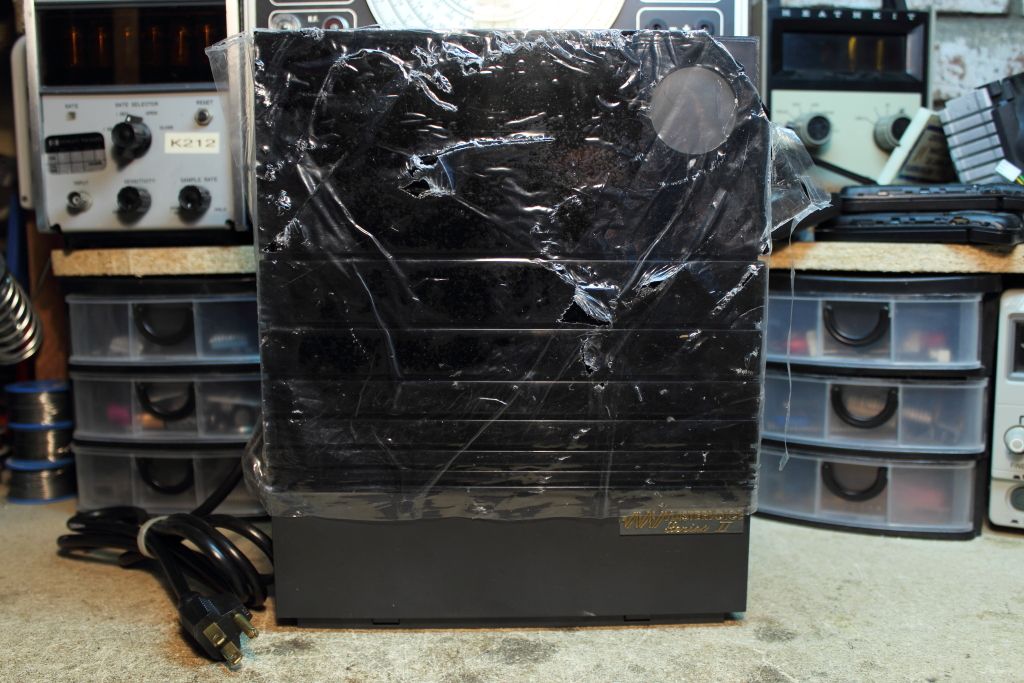
>>IMAGE<<
>>IMAGE<<
>>IMAGE<<
As you can see it's not too monolithic but the design feels really 80's. The front was also rather roughed up. The VFD and ports for the speaker and microphone hide behind a smoked plexiglass panel (which you can see has a corner missing). The white circle hides the motion sensor and the bottom flips down to reveal not only all the function buttons but a very nice diagram of the menu system. On the back you can see the ports for the phone, external speaker and microphone, serial, parallel controls for volume and microphone sensitivity...and another odd 3.5mm plug in the far corner with no labeling. I wonder what that is for? Behind the square panel is a location for five AA batteries for memory protection and a red button which I believe is for resetting the system.
The machine was sold to me as "Not Working". The VFD would not light. We were also missing the PIN because for some ridiculous reason you need to enter that whenever the unit loses all power. I assume it was to prevent people from stealing the unit but it also means that if you do not have the PIN you're SOL unless you want to try all 10000 combinations.....or perhaps see where they programmed it? Between that, the malfunctioning VFD and the fact that the last guy who pulled one open was REALLY lacking in the balls to dismantle it, even though he loves electronics, I think we'll devote the rest of this entry to what's going on inside.
Before I even opened the unit I decided to closer inspect the VFD.
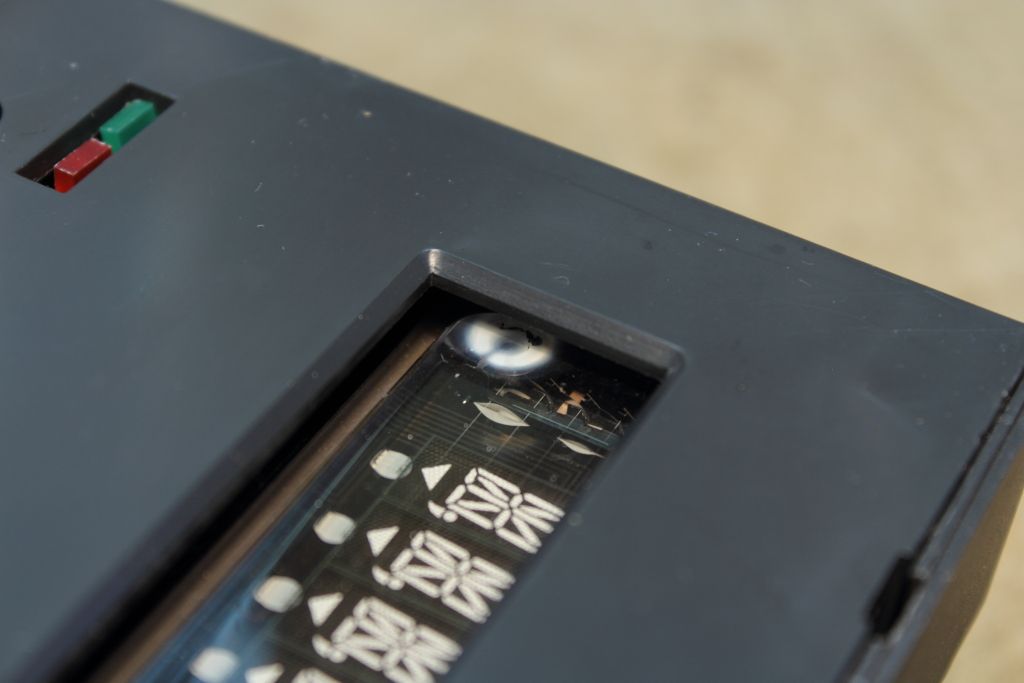
Well the problem is pretty evident. Getter went white. The VFD has lost its vacuum. What on earth happened??
What on earth happened??
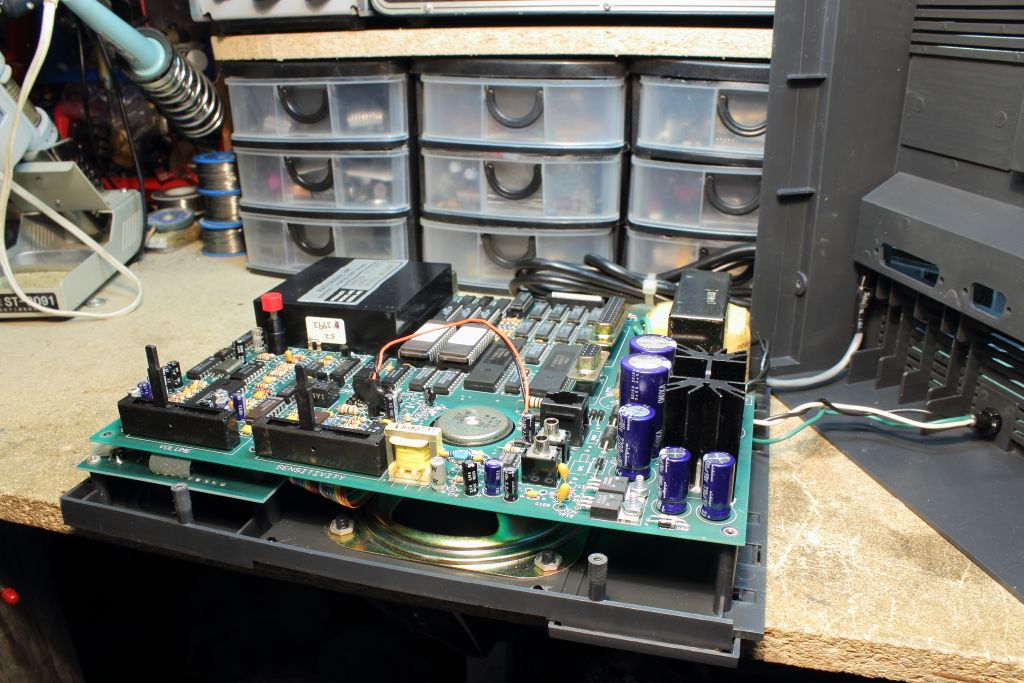
Getting the back off initially is easy. Pop off the rubber caps on the sliders, disconnect the battery pack and remove four screws. The AC input is hardwired in and in my case we gotta contend with that extra jack whose cable snakes somewhere under the main board. Like the last guy as well it's evident that even after the boards were etched the engineers were making a lot of changes. This ridiculous solder job hides in one of the corners.
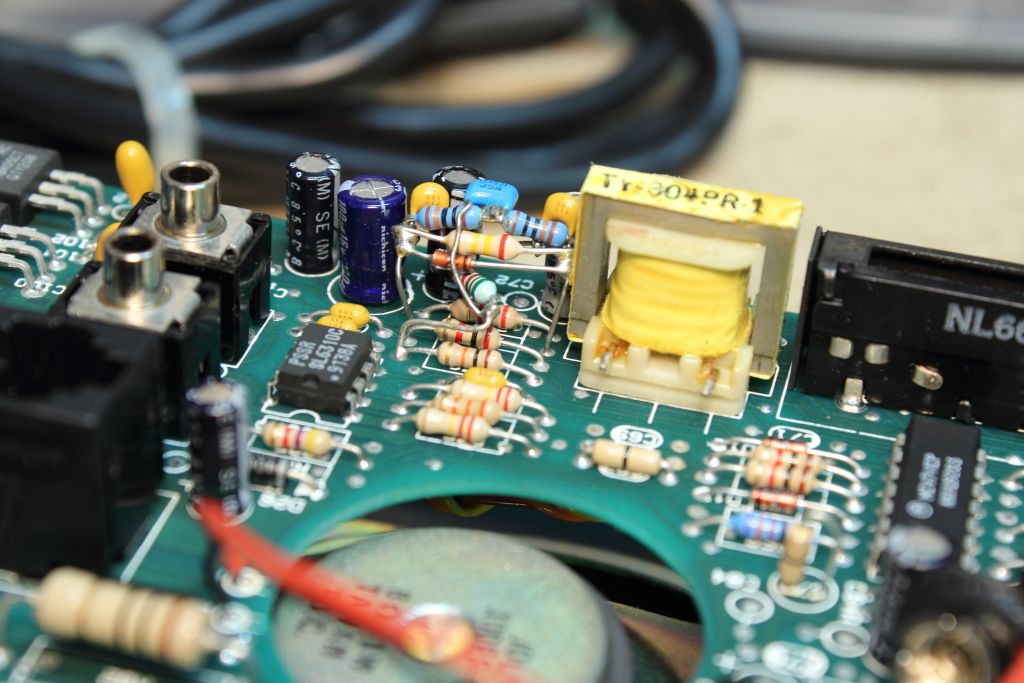
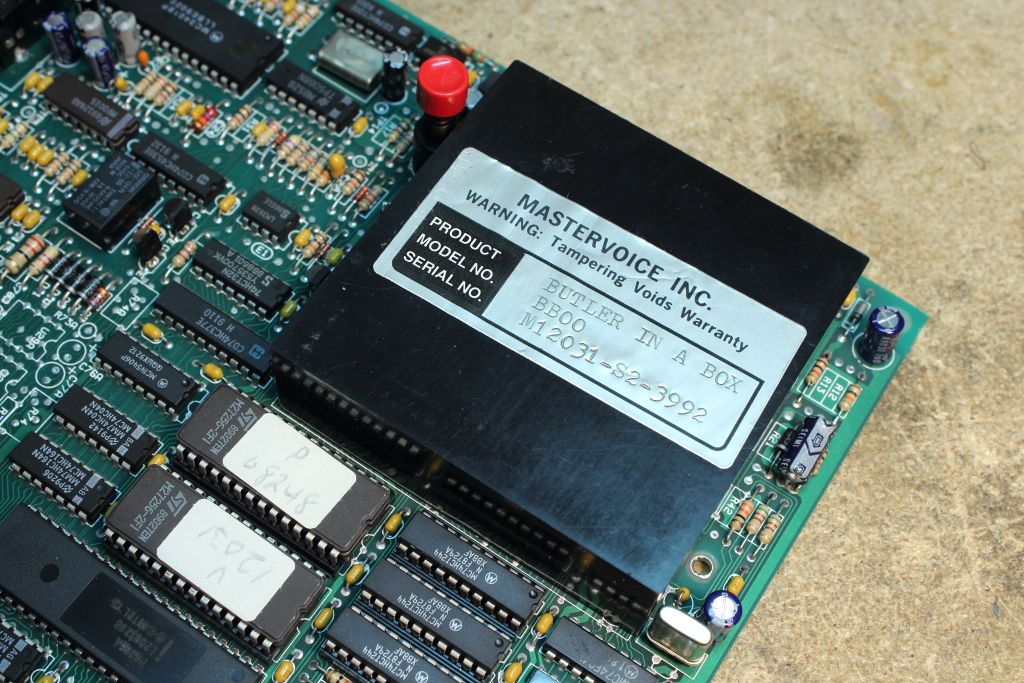
This looks like it's some form of DC-DC regulator but no, it's something WAY more evil. The reset, two ROMs and 16 mhz crystal that surround it along with two 38 pin connectors visible underneath the PCB indicate that THIS is where all of the main logic like the CPU and speech control hides. Potted away inside a block of epoxy. Man, they weren't kidding when they wanted to keep this thing secure. Here's to hoping that the PIN hides on one of those two EPROMs (which I have now dumped as they are regular 27256's).
Now we must go deeper...and now I know why the other guy didn't do that.
>>IMAGE<<

Was this necessary?? Could you seriously not thought of something a bit more elegant? To go any further I had the end up desoldering a half dozen different joints. We did however learn where that extra mysterious jack went. It snakes to the VFD PCB where it passes through a diode and a resistor which travel to a voltage pin and ground. It's for powering some external device. While we now had the VFD assembly free I thought we could wrap up why the envelope had gone to air.
>>IMAGE<<
>>IMAGE<<
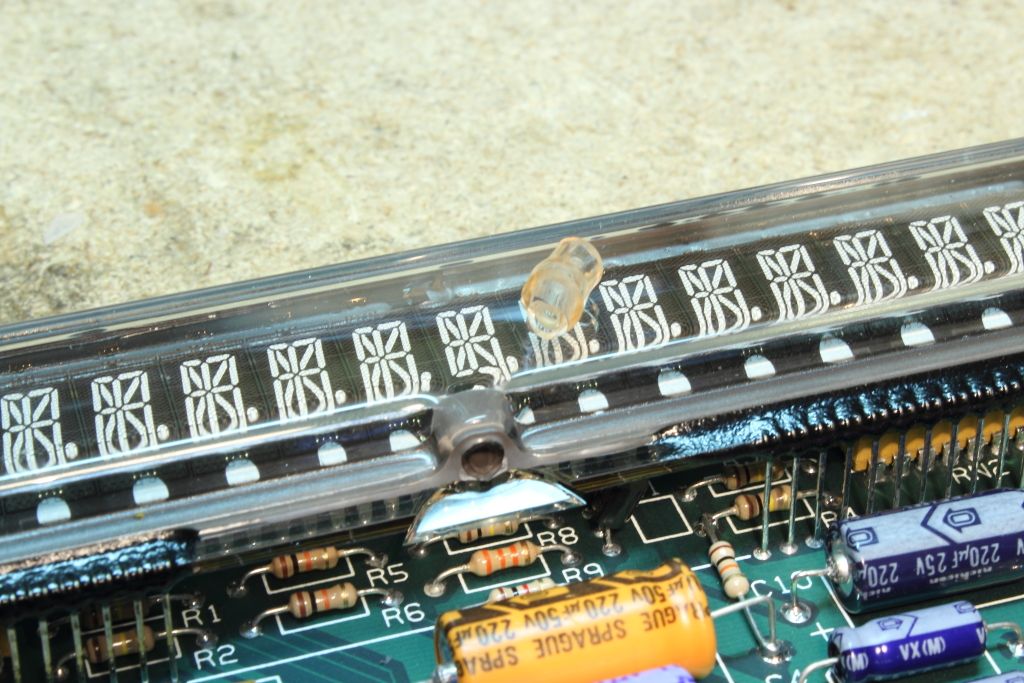
So even though the nipple was protected with a piece of rubber tubing it had been knocked off and was found rattling around inside the case along with some of the plastic pegs that used to hold the plexiglass in. Baffled, I looked at the opening in the plastic front and spotted it. Tool marks. So now we know the reason why the front was so mangled was because someone had pried the front off, then inserted something like a flat bladed screwdriver into the opening and deliberately broken the nipple. Why? Was this for writeoff reasons? Why not just run it over with a car?? Anyways, the VFD (an Itron manufactured FG169C1) is driven by a Micrel 10937P display controller and that's about it for the board aside from the two status LED's and the IR sensor.

>>IMAGE<<
This is what that mess of ribbon cable wiring plugged into. The silkscreening calls it the phone card and is what I can assume is the dialer and telephone interface for the RJ11 jack on the main PCB. Again it isn't all that special aside from an Intel D8751H microcontroller. I've yet to dump that however we might not be able to do that. This chip includes a UV resettable security fuse. If that is set then the difficulty of dumping this ship increases tenfold. Interesting that would use this particular chip for phone control as it is basically an 8051 with a quartz window so you can wipe and reprogram it whereas the regular 8051's use masked PROM's.
Finally there is the main PCB again.
>>IMAGE<<
>>IMAGE<<
We already discussed the black block and the absurd wiring but lets quickly look at the other major components. We can see that there are two Intel P8255A peripheral controllers and an MC 34018P which makes up the speakerphone circuit. Sitting in sockets were the two 27256 UV EPROM's, three 74HCT244 octal buffers and an AM27S19PC 256 bit bipolar PROM. So there's yet another place the PIN could be hiding. We can also clearly see the power supply which is relatively simple and a single relay. The ribbon cable socket on the far side connects the front controls to the board. The only other blatently suspicious component is a ceramic DIP simply marked "MV0014".
And there you have it. That's all the guts inside the case but before we close it up, check out the signatures stamped inside the back cover. I love the little additions like this. Anyways, so what next?
Well obviously the display needs to be replaced as it will be too difficult for me at least to restore the vacuum. We can hope to find another VFD, or we could just replace the display entirely with a row of alphanumeric multisegment LED displays or some backlit LCD panel. The last option is to consider it a basketcase and buy another one since they aren't too expensive but the ultimate goal is to see if there is an easy way to recover the PINs for these machines as many of the units that remain have since parted ways with their manuals and documentation where the PIN was kept. The rear ports are also somewhat useless until their protocols are reverse engineered. It would be awesome if someone actually had a copy of the software that Mastervoice sold. Who knows. It might still be out there.

Indeed, the Butler was pretty advanced for its time and (with this article in particular) it got even better. The later but identical looking "Series II" added enhanced support as well as added serial, parallel and modem ports, plus additional external expansions for relay banks, expanded voice functionality, IR remote control and environmental monitoring. It was also expensive. One unit would set you back $1400.
Of course it also supported X10. Imagine that. a Home automation system that didn't decide to make its OWN protocol. I wish I could see that more often these days. I'm losing count on how many different protocols now exist. X10 might be old as hell, but look how adopted it was not to mention how cheap it was on a per-module basis. NOS lamp modules and light switches are $5 these days.
Anyways, as you might expect from 80's tech it wasn't perfect and Mastervoice closed a few years later due to poor sales and criticism that the Butler in a Box was not as smart as they said it was, taking almost all the support for the boxes with them. What remains now are these relics that float about ebay and flea markets. My particular unit came from ebay where about a half dozen pop up ever year. They aren't too expensive, save for one or two cracked nuts who think otherwise. Usually selling for between $10 and $50 depending on the condition. Sometimes they won't even sell at $10. Mine cost $30.

>>IMAGE<<
>>IMAGE<<
>>IMAGE<<
As you can see it's not too monolithic but the design feels really 80's. The front was also rather roughed up. The VFD and ports for the speaker and microphone hide behind a smoked plexiglass panel (which you can see has a corner missing). The white circle hides the motion sensor and the bottom flips down to reveal not only all the function buttons but a very nice diagram of the menu system. On the back you can see the ports for the phone, external speaker and microphone, serial, parallel controls for volume and microphone sensitivity...and another odd 3.5mm plug in the far corner with no labeling. I wonder what that is for? Behind the square panel is a location for five AA batteries for memory protection and a red button which I believe is for resetting the system.
The machine was sold to me as "Not Working". The VFD would not light. We were also missing the PIN because for some ridiculous reason you need to enter that whenever the unit loses all power. I assume it was to prevent people from stealing the unit but it also means that if you do not have the PIN you're SOL unless you want to try all 10000 combinations.....or perhaps see where they programmed it? Between that, the malfunctioning VFD and the fact that the last guy who pulled one open was REALLY lacking in the balls to dismantle it, even though he loves electronics, I think we'll devote the rest of this entry to what's going on inside.
Before I even opened the unit I decided to closer inspect the VFD.

Well the problem is pretty evident. Getter went white. The VFD has lost its vacuum.

Getting the back off initially is easy. Pop off the rubber caps on the sliders, disconnect the battery pack and remove four screws. The AC input is hardwired in and in my case we gotta contend with that extra jack whose cable snakes somewhere under the main board. Like the last guy as well it's evident that even after the boards were etched the engineers were making a lot of changes. This ridiculous solder job hides in one of the corners.


This looks like it's some form of DC-DC regulator but no, it's something WAY more evil. The reset, two ROMs and 16 mhz crystal that surround it along with two 38 pin connectors visible underneath the PCB indicate that THIS is where all of the main logic like the CPU and speech control hides. Potted away inside a block of epoxy. Man, they weren't kidding when they wanted to keep this thing secure. Here's to hoping that the PIN hides on one of those two EPROMs (which I have now dumped as they are regular 27256's).
Now we must go deeper...and now I know why the other guy didn't do that.
>>IMAGE<<

Was this necessary?? Could you seriously not thought of something a bit more elegant? To go any further I had the end up desoldering a half dozen different joints. We did however learn where that extra mysterious jack went. It snakes to the VFD PCB where it passes through a diode and a resistor which travel to a voltage pin and ground. It's for powering some external device. While we now had the VFD assembly free I thought we could wrap up why the envelope had gone to air.
>>IMAGE<<
>>IMAGE<<

So even though the nipple was protected with a piece of rubber tubing it had been knocked off and was found rattling around inside the case along with some of the plastic pegs that used to hold the plexiglass in. Baffled, I looked at the opening in the plastic front and spotted it. Tool marks. So now we know the reason why the front was so mangled was because someone had pried the front off, then inserted something like a flat bladed screwdriver into the opening and deliberately broken the nipple. Why? Was this for writeoff reasons? Why not just run it over with a car?? Anyways, the VFD (an Itron manufactured FG169C1) is driven by a Micrel 10937P display controller and that's about it for the board aside from the two status LED's and the IR sensor.

>>IMAGE<<
This is what that mess of ribbon cable wiring plugged into. The silkscreening calls it the phone card and is what I can assume is the dialer and telephone interface for the RJ11 jack on the main PCB. Again it isn't all that special aside from an Intel D8751H microcontroller. I've yet to dump that however we might not be able to do that. This chip includes a UV resettable security fuse. If that is set then the difficulty of dumping this ship increases tenfold. Interesting that would use this particular chip for phone control as it is basically an 8051 with a quartz window so you can wipe and reprogram it whereas the regular 8051's use masked PROM's.
Finally there is the main PCB again.
>>IMAGE<<
>>IMAGE<<
We already discussed the black block and the absurd wiring but lets quickly look at the other major components. We can see that there are two Intel P8255A peripheral controllers and an MC 34018P which makes up the speakerphone circuit. Sitting in sockets were the two 27256 UV EPROM's, three 74HCT244 octal buffers and an AM27S19PC 256 bit bipolar PROM. So there's yet another place the PIN could be hiding. We can also clearly see the power supply which is relatively simple and a single relay. The ribbon cable socket on the far side connects the front controls to the board. The only other blatently suspicious component is a ceramic DIP simply marked "MV0014".
And there you have it. That's all the guts inside the case but before we close it up, check out the signatures stamped inside the back cover. I love the little additions like this. Anyways, so what next?
Well obviously the display needs to be replaced as it will be too difficult for me at least to restore the vacuum. We can hope to find another VFD, or we could just replace the display entirely with a row of alphanumeric multisegment LED displays or some backlit LCD panel. The last option is to consider it a basketcase and buy another one since they aren't too expensive but the ultimate goal is to see if there is an easy way to recover the PINs for these machines as many of the units that remain have since parted ways with their manuals and documentation where the PIN was kept. The rear ports are also somewhat useless until their protocols are reverse engineered. It would be awesome if someone actually had a copy of the software that Mastervoice sold. Who knows. It might still be out there.
